
USS Talladega (APA/LPA-208) was a Haskell-class attack transport of the US Navy. She was of the VC2-S-AP5 Victory ship design type. Talladega was named for Talladega County, Alabama.

USS Mahoning County (LST-914) was an LST-542-class tank landing ship built for the United States Navy during World War II. Like many of her class, she was not named and is properly referred to by her hull designation. She was later named after Mahoning County, Ohio, she was the only US Naval vessel to bear the name.
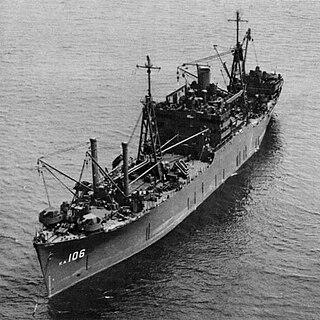
USS Union (AKA-106) was a Tolland-class attack cargo ship of the United States Navy, the fourth ship with this name, and served as a commissioned ship for 25 years and 1 month.

USS Luzerne County (LST-902) was an LST-542-class tank landing ship built for the United States Navy during World War II. Named after Luzerne County, Pennsylvania, she was the only U.S. Naval vessel to bear the name.
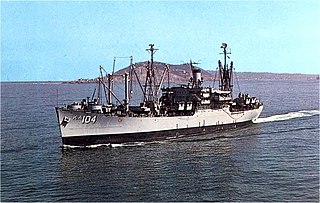
USS Seminole (AKA-104/LKA-104) was a Tolland-class attack cargo ship in service with the United States Navy from 1945 to 1970. She was scrapped in 1977.

USS Trousdale (AKA-79) was a Tolland-class attack cargo ship in service with the United States Navy from 1944 to 1946. She was sold into commercial service and was scrapped in 1968.
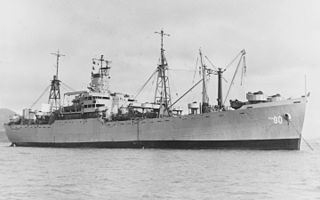
USS Whiteside (AKA-90) was an Andromeda-class attack cargo ship named after Whiteside County, Illinois. She served as a commissioned ship for 13 years and 4 months.

USS Warrick (AKA-89) was an Andromeda-class attack cargo ship in service with the United States Navy from 1944 to 1957. She was sunk as a target in 1971.

USS Alshain (AKA-55) was an Andromeda-class attack cargo ship in the service of the United States Navy. She was named after the star Alshain in the constellation Aquila, and served as a commissioned ship for 11 years and 9 months.

USS Chara (AKA-58) was an Andromeda-class attack cargo ship named after a star in the constellation Canes Venatici. She was later converted to an ammunition ship and redesignated (AE-31).
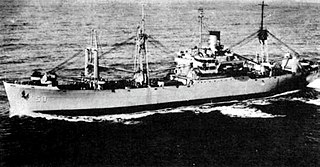
USS Diphda (AKA-59) was an Andromeda-class attack cargo ship named after a star in the constellation Cetus. She served as a commissioned ship for 11 years and 10 months.

USS Virgo (AKA-20) was an Andromeda class attack cargo ship of the United States Navy, named after the constellation Virgo. She was later converted to an ammunition ship and redesignated as (AE-30). She served as a commissioned ship for 22 years and 4 months.

USS Hinsdale (APA-120) was a Haskell-class attack transport ins service with the United States Navy from 1944 to 1946. She was scrapped in 1974.

USS LST-900 was an LST-542-class tank landing ship in the United States Navy during World War II. Late in her career, she was renamed Linn County (LST-900)—after counties in Iowa, Kansas, Missouri, and Oregon—but saw no active service under that name.
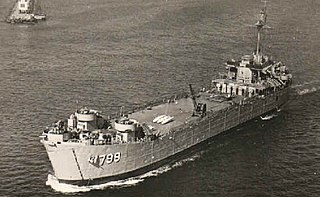
USS Greer County (LST-799) was a LST-542-class tank landing ship (LST) built for the United States Navy during World War II. She was named for Greer County, Oklahoma on 1 July 1955, and the only U.S. Naval vessel to bear the name.
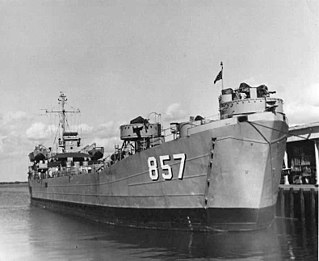
USS King County (LST-857) was an LST-542-class tank landing ship built for the United States Navy during World War II. Named after counties in Texas and Washington, she was the only U.S. Naval vessel to bear the name.
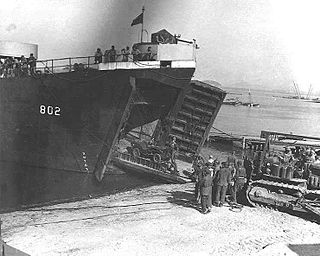
USS Hamilton County (LST-802) was an LST-542-class tank landing ship built for the United States Navy during World War II. Named after counties in Florida, Illinois, Indiana, Iowa, Kansas, Nebraska, New York, Ohio, Tennessee, and Texas, she was the only U.S. Naval vessel to bear the name.

USS Lafayette County (LST-859) was an LST-542-class tank landing ship built for the United States Navy during World War II. Named after counties in Arkansas, Florida, Mississippi, Missouri, and Wisconsin, and a parish in Louisiana, she was the only U.S. Naval vessel to bear the name.

USS Pickens (APA-190) was a Haskell-class attack transport in service with the United States Navy from 1944 to 1946. She was scrapped in 1973.

USS George Clymer (APA-27) was an Arthur Middleton-class attack transport that saw service with the US Navy in four wars - World War II, the Chinese Civil War, the Korean War and the Vietnam War. It was named after United States Founding Father George Clymer.




















